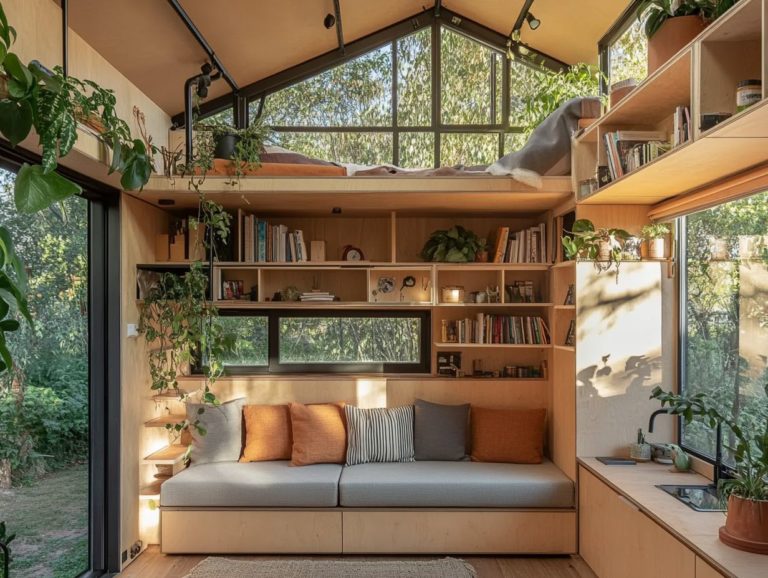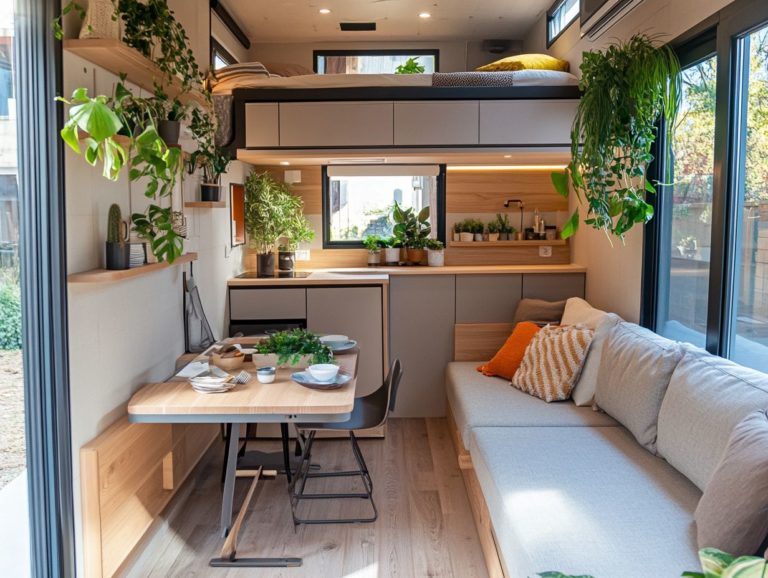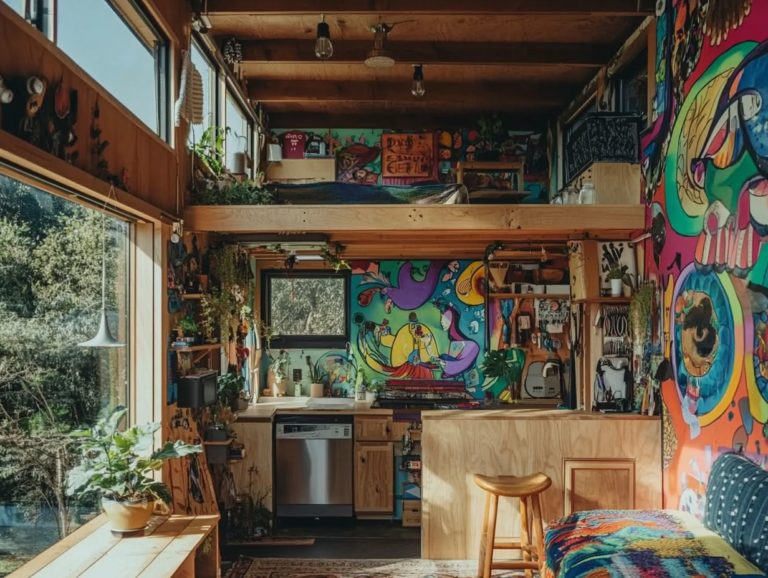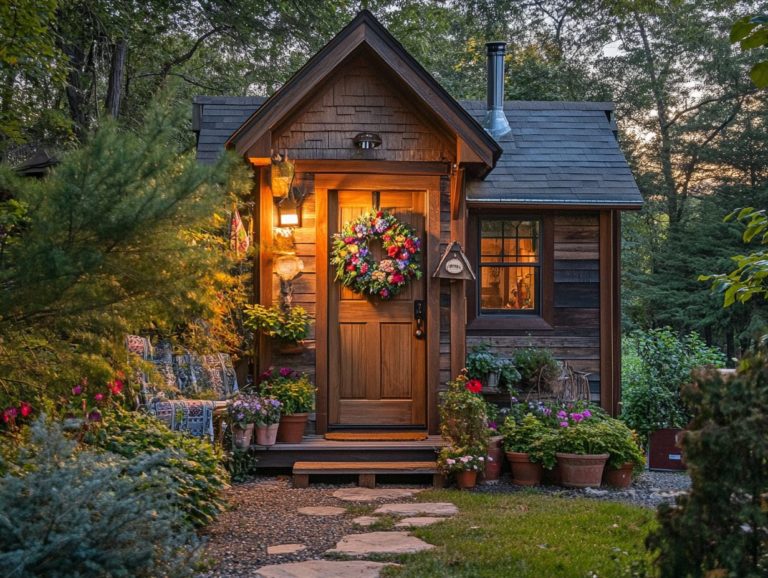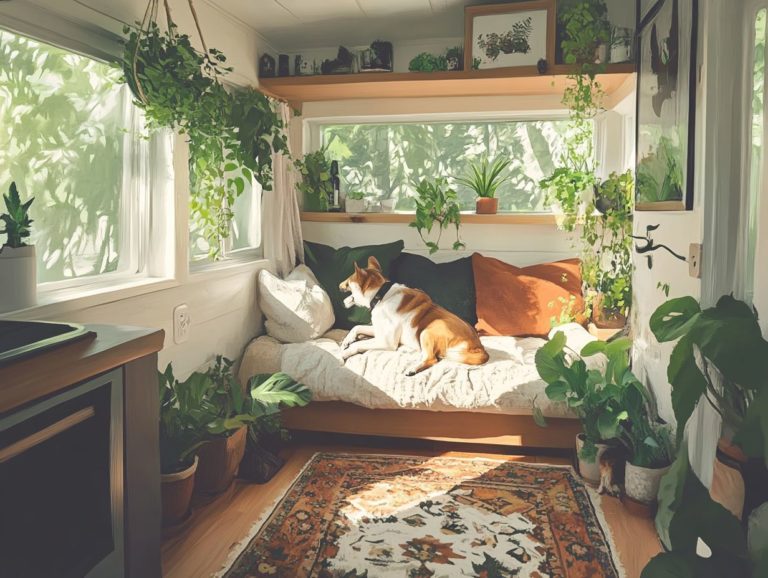5 Ways to Optimize Lighting in Tiny Spaces
In small spaces, lighting plays a pivotal role in determining whether you feel cramped and confined or open and welcoming.
Whether you aim to brighten a narrow hallway or elevate a tiny living room, your lighting choices can truly transform your environment.
This guide delves into five effective strategies for optimizing light in compact areas, covering everything from harnessing natural sunlight to selecting the perfect fixtures.
Get ready to uncover common pitfalls that can dim your space! You ll also discover creative ideas that will help you maximize your space with effective illumination.
Prepare to illuminate your home like never before!
Contents [hide]
- Key Takeaways:
- 1. Utilize Natural Light
- 2. Use Light-Colored Paint or Wallpaper
- 3. Incorporate Mirrors
- 4. Choose Appropriate Lighting Fixtures
- 5. Use Task Lighting
- How Does Lighting Affect the Perception of Space?
- Frequently Asked Questions
- What are the benefits of optimizing lighting in tiny spaces?
- How can I make the most out of natural lighting in a tiny space?
- What types of artificial lighting should I consider for a tiny space?
- How can I create the illusion of more space through lighting?
- Are there any lighting fixtures specifically designed for tiny spaces?
- What are some tips for optimizing lighting in tiny spaces?
Key Takeaways:

- Maximize natural light by keeping windows unobstructed and using light-colored curtains.
- Opt for light-colored paint or wallpaper to create the illusion of a larger space.
- Incorporate mirrors strategically to reflect light and create the perception of depth.
1. Utilize Natural Light
Utilizing natural light is essential when creating an inviting atmosphere, particularly in small spaces. It not only enhances spatial perception but also improves energy savings.
It also provides many health benefits for those who inhabit the space.
Consider innovative window arrangements like clerestory windows and corner windows. They can significantly increase natural light and contribute to a brighter atmosphere.
Along with strategic window placements, think about incorporating skylights. They can greatly increase sunlight, especially in rooms that lack adequate wall space for traditional windows.
The thoughtful selection of semi-sheer curtains can also be pivotal, allowing sunlight to filter through while maintaining your privacy.
These enhancements do more than elevate the overall aesthetic; they foster a warm environment that supports mental well-being by reducing your reliance on artificial lighting.
By optimizing natural light, you can create a healthier living space that minimizes energy consumption, leading to lower utility bills and a reduced environmental footprint.
2. Use Light-Colored Paint or Wallpaper
Using light-colored paint or wallpaper can truly transform your perception of space, making small rooms feel larger and more inviting.
This is achieved by enhancing light reflectance and creating an ambient atmosphere.
The magic lies in high LRV (Light Reflectance Value) paints, which effectively bounce light around the room, diminishing shadowy corners.
Soft hues like pale blues, light grays, and off-whites not only brighten the space but also evoke feelings of tranquility and openness.
The psychological effects of color play a significant role in influencing mood. Warm shades can create a cozy vibe, while cooler tones promote calmness.
Therefore, choosing light shades becomes essential in crafting an inviting and expansive environment.
3. Incorporate Mirrors
Incorporating mirrors into your decor can dramatically transform small spaces. They create an illusion of depth and beautifully reflect natural light.
This makes areas feel larger and more open.
By strategically placing mirrors across from windows or other light sources, you can effectively amplify sunlight throughout the room.
Different types of mirrors whether oversized floor mirrors, sleek wall-mounted designs, or chic decorative accents not only serve practical purposes but also add a touch of elegance and style.
Reflective surfaces enhance the ambient atmosphere, inviting light to dance across the room and creating a cozy, welcoming environment.
Take these steps today, and watch your small spaces transform into bright, welcoming areas!
4. Choose Appropriate Lighting Fixtures
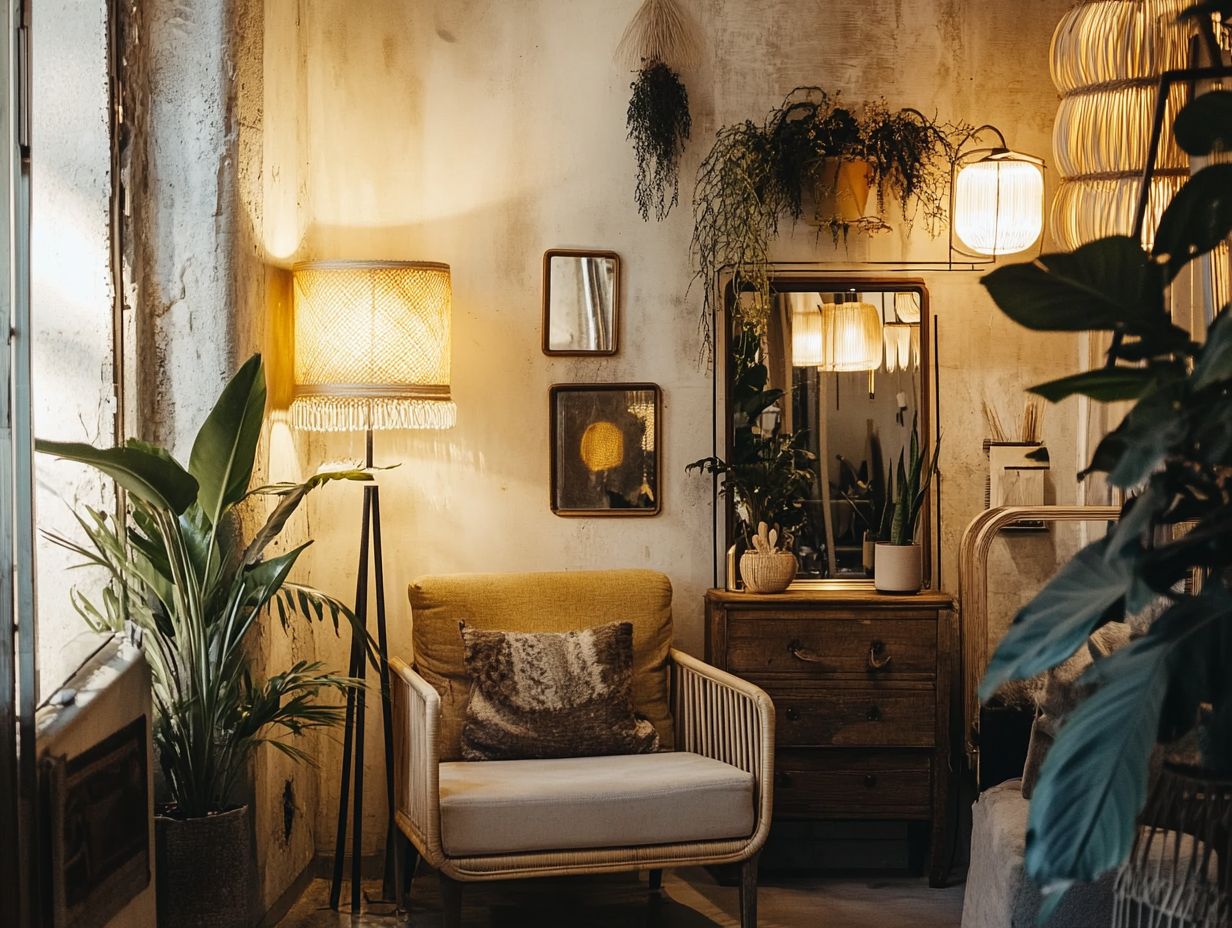
Choosing the right lighting fixtures is essential for enhancing both the functionality and aesthetics of your small spaces. Consider incorporating vintage sconces, mid-century light fixtures, and wall sconces; these not only illuminate the area but also infuse character and style.
In these cozy environments, ceiling lights often take center stage, delivering vital overhead illumination that can create the illusion of more spaciousness. Meanwhile, wall sconces serve a dual purpose: they provide subtle accent lighting while freeing up precious floor space. To maximize your space further, consider these 5 ways to stay organized in a tiny house.
The choice of materials be it delicate glass shades or sleek metal finishes can significantly influence how light is reflected, contributing to a warm ambiance. By thoughtfully combining these elements, you can achieve a harmonious balance among task, ambient, and accent lighting, transforming even the most compact areas into inviting and functional havens.
5. Use Task Lighting
Task lighting is crucial for small spaces, giving you the focused illumination necessary for activities like reading, cooking, or working. You can achieve this with portable lights, dimmable fixtures, and innovative smart bulbs tailored to your specific needs.
The right lighting can significantly enhance your productivity, ensuring tasks are performed efficiently while reducing eye strain. Portable lighting options provide the flexibility you need, allowing you to position lights exactly where they’re most effective, whether it’s a cozy nook for that gripping novel or the kitchen counter as you whip up dinner. For those living in a tiny space, consider these 8 ways to make your tiny house feel spacious to maximize your environment.
Dimmable lights offer you an additional layer of control, allowing you to adjust the brightness to match the time of day or the task at hand, elevating both comfort and concentration. By integrating smart bulbs into your lighting scheme, you can further customize your environment, effortlessly crafting the perfect ambiance that aligns with your mood or activity.
How Does Lighting Affect the Perception of Space?
Lighting plays a pivotal role in how you perceive a space. It influences not just the dimensions and details of a room but also elevates the overall atmosphere through ambient lighting and thoughtful light reflectance strategies.
When you strategically use different types of lighting, you can dramatically transform your experience of a space. For instance, ambient lighting creates a warm and inviting environment, making rooms feel more expansive and welcoming. On the flip side, task lighting hones in on specific areas, like workspaces, enhancing functionality while keeping the area from feeling cramped. Then there s accent lighting, which highlights unique features or artworks, adding depth and intrigue to your design.
Together, these lighting types shape not only how large or small a space feels but also significantly contribute to the psychological and emotional comfort you experience within it.
What Are the Best Types of Lighting for Small Spaces?
The best types of lighting for small spaces feature a blend of ambient, task, and accent lighting, each playing a crucial role in creating a harmonious and functional environment.
By effectively utilizing these three categories, you can transform a cramped area into an inviting sanctuary that feels much larger than it actually is. Consider implementing 5 ways to optimize small bathroom layouts for maximum efficiency. Ambient lighting offers the overall illumination you need for daily activities, ensuring visibility while also maintaining a warm, welcoming atmosphere.
Task lighting is essential for focused activities like reading or working, directing light precisely where it s needed without overwhelming the space. Accent lighting, on the other hand, highlights specific features or decor elements, adding depth and character.
Together, these lighting types not only enhance functionality but also elevate the aesthetics of small spaces, making them feel more inviting and open.
How Can One Make the Most of Limited Natural Light?
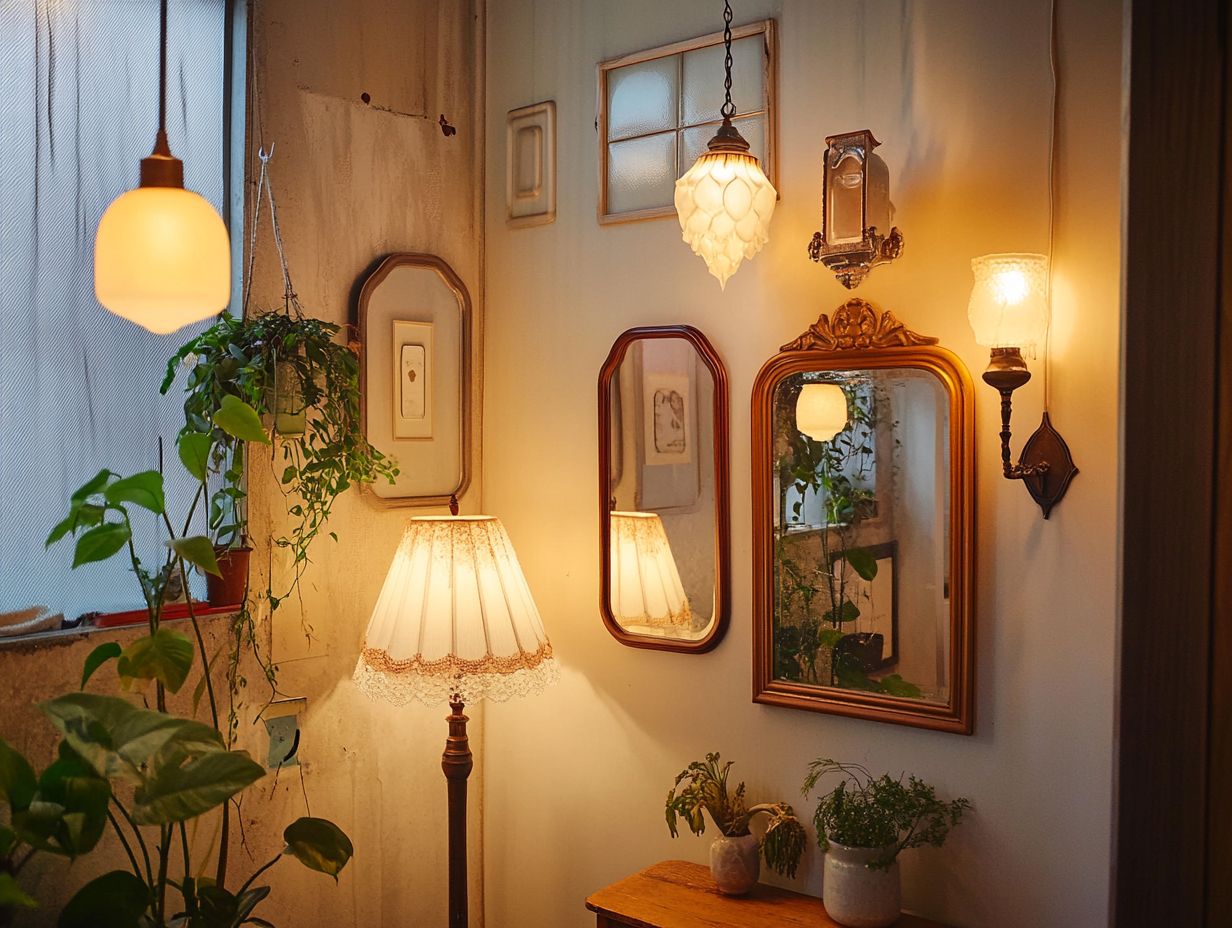
Let s discover how to brighten your space today! To maximize the limited natural light in your area, consider using strategies such as reflective surfaces, light colors, and thoughtfully arranged windows. These techniques enhance brightness and create a more inviting mood.
By strategically placing mirrors on your walls, you not only bounce daylight around the room but also create the illusion of a larger space. Choosing light-colored decor—think soft whites, pale blues, and muted pastels—further aids in reflecting light. Understanding the impact of lighting on tiny house design makes even the coziest corners feel more expansive.
Don’t underestimate the impact of the right window treatments. Opting for sheer curtains allows natural light to filter in while still maintaining your privacy. Together, these elements work in harmony to elevate any dimly lit area, transforming it into a warm and welcoming sanctuary.
What Are Some Common Lighting Mistakes in Tiny Spaces?
Common lighting mistakes in tiny spaces often stem from relying on a single light source, neglecting to incorporate multiple options, and allowing clutter to obstruct the natural flow of light and energy.
These pitfalls can significantly compromise both the mood and functionality of your compact room. If you depend solely on an overhead fixture, you may find yourself battling insufficient illumination, with shadowy corners that contribute to a sense of confinement. To maximize your space effectively, consider these 7 tips for decluttering tiny spaces.
To elevate the lighting experience, consider layering different types of fixtures. Think of adding table lamps, floor lamps, and wall sconces. This combination collectively enhances brightness and fosters a warm, inviting atmosphere. Additionally, understanding the role of light in tiny house space design can further improve your setup.
Maintaining an uncluttered environment is crucial. Excess furniture and decor can block light, resulting in a chaotic appearance. By thoughtfully selecting your light sources and minimizing visual clutter, you can transform a small space into a more open and vibrant area. Consider 7 creative ways to partition tiny spaces to enhance your area further.
How Can Lighting Be Used to Create the Illusion of Space?
Lighting serves as a remarkable tool to create the illusion of space in your environment. By strategically placing light sources, enhancing vertical height, and crafting an inviting mood, you can draw the eye upward and outward, making your space feel more expansive.
Incorporating uplighting shining lights up towards the ceiling can significantly elevate the perceived height of a room, giving it an airy, open feel. Alternatively, downlighting can illuminate specific areas, establishing comfortable nooks while making adjacent spaces seem larger. For more tips on optimizing your space, check out 7 ways to enhance functionality in tiny spaces.
When you pair these lighting techniques with thoughtful color choices like light colors that reflect light effectively and streamlined decor, such as glossy finishes, you can effortlessly transform even the coziest spaces into areas that exude a sense of ample warmth and invitation. For more ideas on creating a bright atmosphere, check out maximizing natural light in tiny house designs.
What Are Some Creative Ways to Incorporate Lighting in Small Spaces?
Incorporating creative lighting solutions into your small spaces can elevate the overall mood. Make the most of multifunctional furniture, portable lights, and the enchanting allure of candlelight to achieve both style and functionality.
By blending practicality with aesthetics, you can transform even the coziest rooms into inviting retreats. Picture a sleek coffee table with integrated LED strips that not only illuminate the surface but also cast an ethereal glow throughout the area. Adjustable wall sconces can add depth and tastefully highlight your artwork, allowing you to maximize natural light in tiny homes and make the most of every inch of your limited square footage.
Let s not overlook the charming touch of strategically placed candles. They effortlessly set the mood and provide versatility for any occasion. Emphasizing adaptability in your design ensures that these lighting methods enhance your space’s character while maintaining a stylish, harmonious look.
Frequently Asked Questions
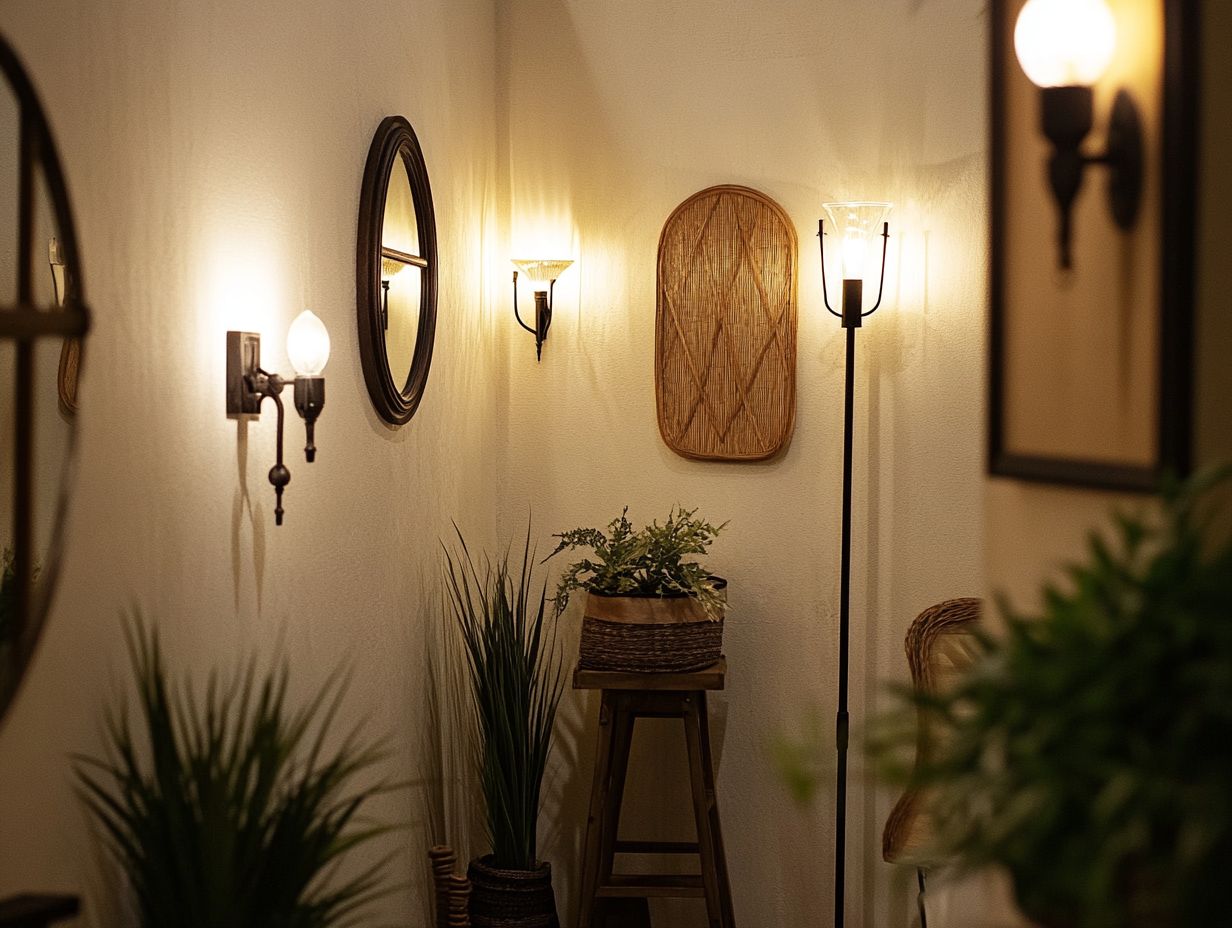
What are the benefits of optimizing lighting in tiny spaces?
Optimizing lighting can make your space feel larger and improve functionality. It also creates a comfortable and inviting atmosphere.
How can I make the most out of natural lighting in a tiny space?
To maximize natural light, use semi-sheer curtains. Place mirrors strategically to reflect light and keep windows clean to let in as much light as possible.
What types of artificial lighting should I consider for a tiny space?
LED lights are great for tiny spaces because they are energy-efficient and versatile. Task lighting, like under-cabinet lights, offers targeted illumination for specific activities.
How can I create the illusion of more space through lighting?
Using different layers of lighting creates depth and dimension. Ambient, task, and accent lighting can make a small area appear larger.
Are there any lighting fixtures specifically designed for tiny spaces?
Yes! Recessed lighting, wall sconces, and track lighting are ideal for small areas. These fixtures are compact and easy to install without taking up much room.
What are some tips for optimizing lighting in tiny spaces?
Use dimmer switches to control light intensity. Avoid cluttering the space with too many fixtures, and experiment with different combinations to find what works best for you!

